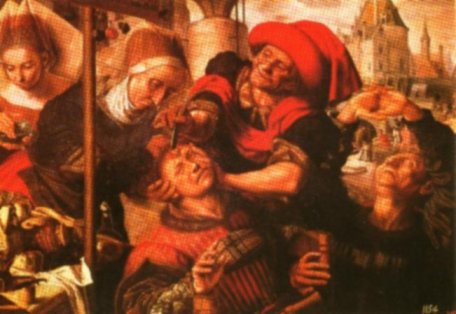The stone-cutter
Jan Sanders van Hemessen (about 1500-after 1575), detail from a tablet
(Prado Madrid, Photograph Giraudon, Paris)
In the Renaissance, stones were regarded to cause epilepsy. People believed themselves to be more enlightened and more scientific, and the demons which came out of the mouth of the person with epilepsy and were supposed to be the cause of the disease, gradually disappeared in the visual arts. Now it was gemstones which were believed to act as a remedy or an amulet against epilepsy.
The following example is taken from a book written by the doctor Antonius Mizaldi:
'Aristotle and later Albertus write that an emerald worn round the neck prevents people from contracting the falling sickness and sometimes drives the sickness away. For this reason families of the nobility like to give their children this stone to wear round their necks so that they do not get this evil disease.'

However, the stone which caused the disease was believed to be in the brain and had to be surgically removed. The quacks experienced a boom during this period and were able to demonstrate their 'skill' at markets and fairs with much blood and gore.
The scene painted by Jan Sanders van Hemessen shows a stone cutter at a fair. The surgeon, who is clearly happy that his operations have been successful, painstakingly moves his knife towards the stone, which is already visible. Behind him hang stones which have been successfully cut out of the head of other patients as a sign of his skill. Next to the quack stands a man who is wringing his hands in desperation - he is clearly going to be the next patient under the scalpel.
--- close this window ---